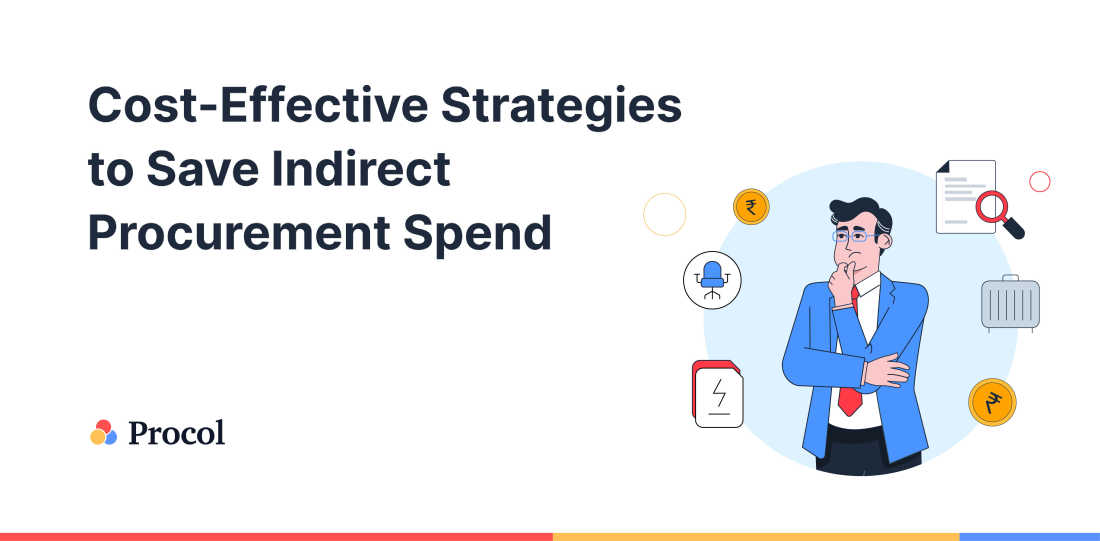Cost-Effective Strategies to Save Indirect Procurement Spend

TABLE OF CONTENTS
According to a McKinsey research, indirect expenses account for an average of 10-15% of sales in the retail business. The problem with disregarding indirect spend is that you may miss out on savings possibilities that can significantly influence your organisation’s bottom line, especially during market turbulence and business uncertainty. Whereas, with the help of indirect procurement, it is possible to save substantially more. Fortunately, there are simple methods entrepreneurs may take to reduce indirect spending and save money.
Tips To Control Indirect Procurement
1. Increase your range of vision
The first step in managing indirect expenditure is to understand its categories, the total amount of indirect spending and the precise locations where this spending is directed. It allows you to make informed judgments about where to save, what to move, where to renegotiate, and more. Procurement and finance teams can utilise technology and operational enhancements to obtain visibility on spend data for all purchases made through the platform, including indirect investments. For example, you may discover that indirect expenses, such as software subscriptions, are beginning to rise even though you no longer require as many subscriptions as you formerly did. Knowing your actual indirect cost can assist in realising what needs to be controlled. Gaining organisational buy-in to follow indirect procurement standards may assist finance and procurement teams gain the control they need to keep track of indirect expenditures.
2. Structured Institutional Framework
Indirect procurement may adopt a decentralised approach, with numerous internal stakeholders managing their budgets and expenditure processes. Teams may benefit from the centralised structure provided by procurement software solutions, which results in increased productivity, cost savings, and compliance.
3. Automated Procure-to-Pay
Making the P2P (Procure-to-Pay) process more effortless, standardised, and automated allows you to control expenses better, increase transparency, and promote cooperation. This comprises all product and service requisitions, purchases, receipts, payments, accounting, and others. Furthermore, it may improve connections with your suppliers by effectively maintaining supplier information and engaging with relevant suppliers throughout the P2P lifecycle.
4. Make Your Sourcing Efforts More Strategic
Making your sourcing efforts more strategic can significantly impact your company. A disciplined approach to supply market analysis will provide you with the best possible market values. It will also result in long-term savings and reduced time in the P2P lifecycle. Furthermore, it will assist in identifying opportunities for overall performance improvement.
5. Organise Your Spending
Create a hierarchy structure that reflects the organisation and is supported by data quality once everyone is aligned. There are systems where companies try to get into very detailed levels, but there are no data points to back up the classification. In these cases, classification errors and untrustworthy data dominate the discussion. As long as the category managers can do their jobs well, that should suffice.
6. Compare Manufacturers
You may wonder if you’re getting the best deal on indirect purchases when you question your spending. Instead of purchasing the same items over and over, consider comparison shopping for all purchases. For example, employees should be able to view products from multiple vendors when procuring indirect items such as office supplies. Items like printer paper and ink may not differ significantly in quality from supplier to supplier, so comparing can help keep indirect spending low. Some e-procurement softwares can even compare vendors automatically to recommend low-cost products and services.
7. Policy Should Be Replaced With Systems
No matter how detailed your e-procurement policies are, a busy end-user who must make an immediate purchase could reject them. Replace policies with a user-friendly system that makes stakeholder’s compliance unavoidable. Using procurement software, implementing spend approvals, catalogues, or purchasing cards, for example, could make purchasing easier for buyers. By creating approval workflows. e-procurement softwares can monitor, control, and decrease unnecessary indirect spending in your firm.
8. Learn Why Maverick Spending Occurs
E-procurement professionals dislike irregular spending, but it may help to view it as an opportunity. What is causing this? Which categories are the most impacted by irresponsible spending? If you have serial miscreants in your business who consistently disregard e-procurement protocols, one of the most helpful things you can do is analyse such spend and conduct awareness programs for business teams.
9. Electronic Automation Automating time-consuming manual tasks like invoicing can help you focus on more strategic indirect strategies while saving money. Electronic invoicing can help cut cycle times and lower invoice costs significantly.
Save With Indirect Procurement
Implementing these steps will allow your finance and e-procurement teams to begin to slow down and save indirect spending, which will benefit your bottom line. The Dryden Group claims that, even though it can appear like a small portion of a production-specified budget, “Manufacturers specifically can spend 20 percent or more on indirect expenses.” The possibility of increasing profits by such an amount is enormous.
Want to learn more about how Procol can help you control indirect spending and save money? Schedule a demo today.
Get a Free Demo
We'd love to hear from you. Please fill out this form to schedule a demo with us. You can also give a call on +91 76666 82222



